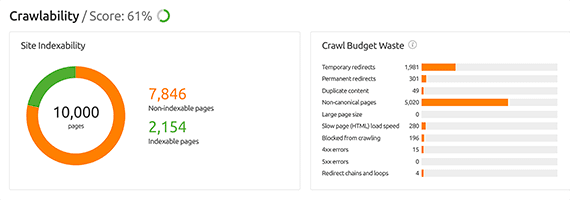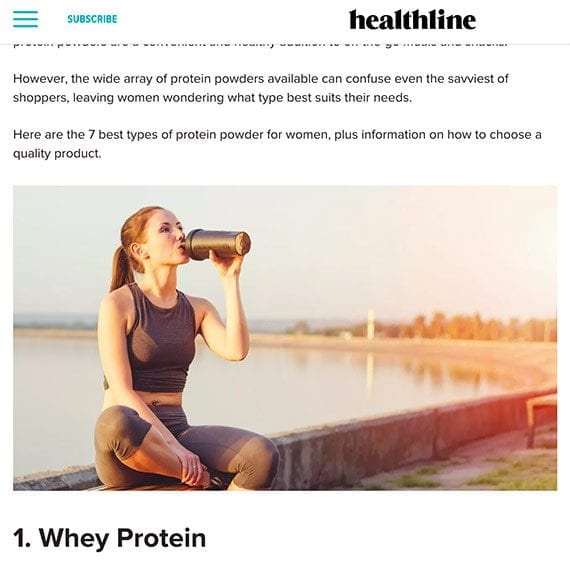
SEO tools can help identify problems that contribute to your site’s lost organic search traffic. This screenshot is from SEMrush.
If you own or manage an ecommerce business and organic search traffic drops suddenly, it can feel like the sky is falling. Your company may be forced to invest more in performance marketing to keep up sales. Profits could vanish.
Moreover, you might not know what went wrong. Here are a few tips for diagnosing a steep drop in organic traffic to your company’s ecommerce website.
Diagnosing Losses in Organic Search Traffic
1. Check your site. Start the diagnosis on your company’s web pages. Make certain that the site is functional and that the pages impacted (the ones losing traffic) are loading correctly, being tracked properly, and are not blocking or stopping the indexing process.
- Identify which pages are dropping. Using your company’s search engine optimization or analytics platform, determine which pages are losing traffic. Is it the entire site? Or a section of the site? This may provide clues to what is happening.
- Check Google Search Console. Look for errors and excluded pages under the “Coverage” tab of Search Console. You may find that 404 errors, a “crawl anomaly,” redirect errors, or canonical tag mistakes have removed some of your pages from Google’s index. Also, check Search Console’s “Manual actions” tab. Is your site suffering from a penalty?
- Check SEMrush or Ahrefs. Conduct a site audit with an SEO tool such as SEMrush or Ahrefs. Look for crawl errors. You may find problems with redirects, canonical tags, or mixed content (i.e., HTTP and HTTPS). You could also identify 404 or 500 errors. Finally, has the average position on search engine results pages fallen for affected pages?
- Check analytics tags. Ensure that you have properly included the analytics script or tags. Sometimes a change to your site’s code, for example, could have removed or disabled Google Analytics script or similar.
- Check your sitemaps and robots.txt file. Did you make any changes to your sitemaps? Did you accidentally add “nofollow” or “noindex” to your robots.txt file?
- Check structured data markup. Ensure that you have correctly implemented structured data markup using, preferably, JSON-LD.
- Look for other changes. Did your company implement a redesign? How about a platform change?
2. Consider your competition. If you cannot resolve the issue using the steps above, identify several keyword phrases for which your site’s organic traffic has dropped and check the competition for those phrases.
- Analyze the keywords. Again using Ahrefs, SEMrush, or similar, analyze the keywords for which your pages are losing traffic. Then identify which of your competitors’ pages are getting the traffic and investigate other potential keywords that could be driving their volume for which your company’s site is not optimized.
- Compare content. Look at the page content. Did your company’s competitors up their game and publish better content on the topic than your site offers?
For example, take the keyword phrase “best protein powder for women.” The top organic search result at the time of writing was for an article on Healthline titled “The 7 Best Protein Powders for Women.” In contrast, one of the most recognizable ecommerce brands for protein powders, Bodybuilding.com, didn’t show up until position 11 with a landing page called “Best Protein Powders for Women.”

Content quality may also impact how much organic search traffic your company’s ecommerce site receives. It may be that a competitor has produced new or better content.
The Healthline article is relatively long and in-depth. It receives about 24,000 monthly visits and ranks for more than 2,000 keyword phrases, according to SEMrush. The Bodybuilding.com article is comparatively short and doesn’t entirely answer the question of which protein powders are best for women. That page gets about 1,300 monthly visits.
If you managed SEO for Bodybuilding.com, you could have the content on this page rewritten. You might want to update it to provide a better answer to the implied question “what is the best protein powder for women and why.” Target all of the associated keyword phrases your competition is using, add some video, and be sure to link to your products or include lead generation opportunities.
Google wants to show the best possible content. Competition is often the reason your organic traffic is falling.
3. Check your backlinks. A significant drop in backlinks can often lead to a substantial decrease in organic site traffic. Here again, use a popular SEO tool — Ahrefs, SEMrush, Majestic, or similar — to look for changes in your site’s backlinks. Did the number or quality of referring domains change?
4. Is the drop seasonal? Could the drop in traffic be part of the normal trend for your products? If you sell ski equipment, for example, it is presumably normal for significantly less organic site traffic in July than November. Compare your site’s traffic to the same period last year. Take into account your overall traffic growth in the past year.
Comments are closed.